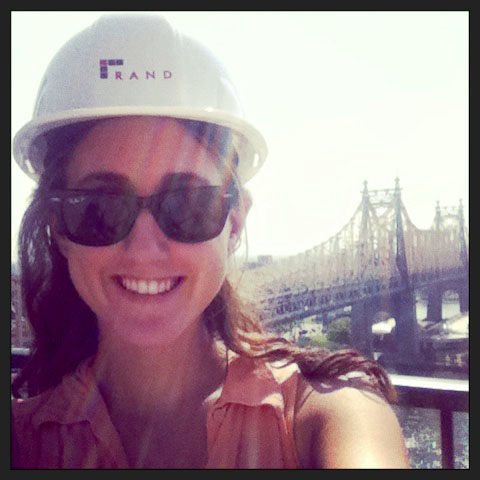
RAND summer intern Grace Zammitti on a Sutton Place rooftop, with the Queensboro Bridge in the background.
After completing my second year at the University of Virginia’s School of Engineering, I was ready for a break. It was finally summer—that time of the year when students relax, take a break from the learning and the problem solving, and put their feet up.
Well, that’s not exactly how I spent my summer.
Even though I wasn’t in school, my second summer internship with RAND taught me a thing or two.
Last summer I worked with RAND’s Survey and Mechanical/Electrical/Plumbing teams. This summer I was put on RAND’s Facade team and learned about a lot more than just building exteriors. While I picked up important technical knowledge —a course of brick versus a wythe of brick, how to install an outrigger for a suspended scaffold, and even something as basic as what a lintel is—the most valuable parts of my RAND experience were the people I met here and what they taught me.
If you ask a lay person how an engineer spends his or her days, they would probably picture someone hunched over a desk, typing equation after equation into a TI-89 calculator. But what’s great about this field is the large role communication and human interaction play. Being a project manager (PM) for an engineering or architectural firm requires working closely with clients, contractors, and other engineers and architects. I’ve learned through these 10 short weeks that, contrary to popular belief, being an engineer means being a “people person” which requires communicating with the people around you and being open to change.
Let’s start with the ladies at RAND.
From Stacy I learned efficiency. An efficient PM is always on the move from project to project. Keeping visits short but productive allows a PM to fit more visits into the day. Stacy writes her site visit reports while she’s at the site, which helps her remember the details and get her reports to the client right away. And of course, keeping clients informed as the project progresses is imperative.
When people think of construction, they picture men in hardhats with hammers and power tools. From Albelisa I learned women can be taken seriously in this field, too. When one contractor installed a damaged coping segment atop a new parapet wall, Albelisa made sure the workers fixed the error. It didn’t matter that the foreman argued the coping segment was OK as is. Albelisa knew its condition was substandard and the client would not accept it. Man or woman, being a PM is about quality control and being firm, and Albelisa made sure this job was done right.
From Yessica and Albelisa I learned a successful woman in this industry can still have a family. As more and more women enter the engineering and architecture field, it is gratifying to see successful young mothers raising children and also working hard at a job they love. What more of a role model could a girl ask for?
And of course, I can’t forget the men at RAND.
From Raul I learned about conflict resolution. When a problem arises in a job, it is often the PM who must resolve it. At a property on the Upper East Side, the superintendent and the new property manager were not getting along. Raul carefully and calmly talked to both of them separately and helped the two resolve their issues to create a better working environment. Raul’s role in resolving this conflict allowed the project to move along without delays.
From Luke I learned we often underestimate how much we know. As an intern, my answer to almost every question was: “I’m not sure. I’m just an intern.” But Luke knew how to push me. He’d ask me questions about things I didn’t think I knew the answer to until I answered them. For example, when we were on a rooftop drawing up a proposal for a new job, Luke noticed a slight vibration beneath our feet as we stepped. He asked me what I thought that meant about the roof’s construction. Of course, I replied, “I’m not sure. I’m just an intern”.
But Luke still wouldn’t accept that. He asked me to think about the foundation of the roof and the material that was concealed underneath the pavers.
“Wood?” I guessed.
Bingo. That’s why the roof gave ever so slightly as we walked on it, due to the deflection from the wood deck. Luke taught me to have confidence in myself because I know more than I think I do.
And lastly from John, I learned how fun engineering and architecture can be. Most college interns don’t get the chance to fully appreciate and enjoy their summer internships because the work they’re doing is often mundane and tedious. Not at RAND. John made sure I got the most out of this summer by telling me on my first day that my job was to have fun. It’s easy to get stressed handling a bunch of different projects, just as I can get when I have too many tests. But John reminded me when you step back from the chaos, you realize you are doing what you love, and that’s what really matters.
What do I say when people ask me what I learned this summer? I could talk about window lintels, end dams, or mortar joints. I could talk about brick replacement, masonry ties, or expansion joints. But I’d rather talk about the people I worked with and what I learned from them. For those lessons are the ones that will stick with me for a very long time.
